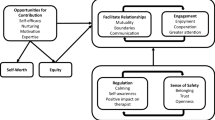Abstract
Pet Therapy reduces apprehension and is, therefore an important tool in working with children and adolescents. Treatment of animals by children is also indicative of their mental health and healthy development. Cruelty to animals may foretell later abuse to humans providing the link between child and animal abuse. Understanding the role of pets as indicators of individual and family problems enable therapists and other professionals to provide the proper counseling for the situation. This paper presents a describes a group work program cognitive behavioral approach with adolescents in pet therapy as an adjunct to treatment in anger management.
Similar content being viewed by others
REFERENCES
Ascione, Frank R. (1993). 'Children who are cruel to animals: a review of research and implications for developmental psychopathology'. “Anthrozoos 6(4):226–47.
Bauer, D.H. (1976). 'An exploratory study of developmental changes in children's fears. “J. Child Psychol. Psychiat.”, 17:69–74.
Beck, A. & Katcher, A.H. (1983). “Between Pets and People: The Importance of Animal Companionship”. N.Y.: G.P. Putnam's Sons.
Bowlby, J. (1973). “Attachment and Loss: Vol. II. 'separation anxiety and anger'. NY: Basic Books.
Bowlby, J. (1988). “A Secure Base: Parent-Child Attachment and Healthy Human Development”. NY: Basic Books.
Corey, Gerald (1996). “Theory and Practice of Counseling and Psychotherapy, 3rd Ed.” CA: Brooks Pub. Co.
Cowles, K.U. (1985). The death of a pet: Human responses to the breaking of the bond. In M.B. Sussman (Ed.), “Pets and Family” (pp.135–148). N.Y.: Haworth Press.
Crick, N.R. & Dodge, K.A. (1994). 'A review and reformulation of social information processing mechanisms in children's social adjustment'. Psychological Bulletin, 115:74–101.
Cunningham, Carolyn & MacFarlane (1996). “When Children Abuse”, Vermont: Safer Society Press.
Felthous, Alan R. & Kellert, Stephen R. (1987). 'Childhood cruelty to Animals and later aggression against people: a review'. “Amer. J. of Psychiat.”, 144:710–17.
Fischer, Joel & Corcoran, Kevin (1994). “Measures for Clinical Practice, 2nd Ed. Vol. I & II”, NY: The Free Press.
Freud, S. (1909). 'Analysis of a Phobia in a five-year-old boy.' “Standard Edition”, 10:5–147. London: Hogarth Press, 1955.
Furlong, Michael J. & Smith, Douglas (Eds.) (1994). “Anger, Hostility and Aggression”, Vermont: Clinical Psychology Pub. Co., Inc.
Katcher, A.H. & Beck, A. (Eds.) (1983). “New Perspectives on Our Lives with Companion Animals”. Philadelphia: University of Pennsylvania Press.
Kendall, P.C. (1991). 'Guiding theory for therapy with children and adolescents'. P.C. Kendall (Ed.) “Child and Adolescent Therapy: Cognitive-behavioral Procedures”, p.3–22. NY: Guilford Press.
Kendall, P.C. (1993). 'Cognitive-behavioral therapies with youth: Guiding theory, current status, and emerging developments'. “J. of Consulting and Clinical Psychology”, 61:235–247.
Kendall, P.C. & Dobson, K.S. (1993). 'On the nature of cognition and its role in psychopathology'.
K.S. Dobson & P.C. Kendall (Eds.), “Psychopathology and Cognition”, p.3–17. CA: Academic Press.
Kendall, P.C. & MacDonald, J.P. (1993). 'Cognition in the Psychopathology of youth and implications for treatment'. “K.S. Dobson & P.C.Kendall (Eds.), Psychopathology and Cognition”, p.387–427. CA: Academic Press.
Kendall, P.C. & Morris, R.J. (1991). 'Child therapy: Issues and recommendations'. “J. of Consulting and Clinical Psychology”, 59:777–784.
Levinson, B.M. (1969). “Pet-Oriented Child Psychotherapy. Springfield: Charles C. Thomas.
Levinson, B. (1970). 'Pets, child development, and mental illness'. “J. of the Amer. Veterinary Medical Assoc., 157:1759–1766.
Levinson, B. (1972). “Pets and Human Development”. Illinois: Charles C. Thomas.
Levitt, M.J. (1991). Attachment and close relationships: A lifespan perspective. In J.L. Gewirtz and W.M. Kurtines (Eds.), “Intersection with Attachment (pp.183–205). N.J.: Lawerence Erlbaum.
Locke, John, “Cruelty,” 116 of Some Thoughts concerning Education, in The Works of John Locke in Nine Volumes, 12th ed. London: C & J Rivington, 8:112–4.
Lockwood, Randall (1986, summer). 'The tangles web of animal abuse: the links between cruelty to animals and human violence'. “The Humane Society of the United States”, 1–6.
Lockwood, Randall & Ascione, Frank R. (1997). “Cruelty to Animals and Interpersonal Violence”, Indiana: Purdue University Press.
Lochman, J.E., White, K.J., & Wayland, K.K. (1991). 'Cognitive behavioral assessment with aggressive children'. P.C. Kendall (Ed.), “Child and Adolescent Therapy: Cognitive-behavioral Procedures”, p.25–65. NY: Guilford Press.
Loney, J. (1971). 'The canine therapist in a residential children's setting'. “This Journal”, 10:518–523.
Malchiodi, Cathy A. (1997). “Breaking the Silence”, PA: Brunner/Mazel.
Mash, Eric J. & Barkley (1996). “Child Psychopathology)”, NY: The Guilford Press.
McWhirter, N., ed. (1981). “Guiness Book of World Records” Ed. 19. N.Y.: Bantam Books.
Moore, L.A. & Hughes, J.N. (1988). 'Impulsive and hyperactive children'. J.N. Hughes (Ed.), “Cognitive Behavior Therapy with Children in Schools”, p.127–159. Toronto: Pergamon Press.
Murdock, J. (1991). “Counseling Children: Basic Principles for Helping thew Troubles or Defiant Child”. NY: Continuum.
Piaget, J. (1929). “The Child's Conception of the World”. N.Y.: Harcourt Brace.
Rose, Sheldon D. (1998). “Group Therapy with Troubled Youth: A Cognitive-Behavioral Interactive Approach”, CA: SAGE Pub, Inc.
Rynearson, E.K. (1978). Humans and pets and attachment. 'British Journal of Psychiatry, 133, 550–555.
C.Schowalter, John E. (1983). 'Clinical experience: the use and abuse of pets'. “J. of the Amer. Acad. of Child Psychiat., 22:68–72.
Seigel, A. (1962). 'Reaching severely withdrawn through pet therapy'. “Amer. J. of Psychiat., 118: 1045–46.
Sendi, I.B. & Blombren, P.G. (1975). A comparative study of predictive criteria in the predisposition of homicidal adolescents'. “Amer. J. Psychiat.”, 132:423–427.
Author information
Authors and Affiliations
Rights and permissions
About this article
Cite this article
Hanselman, J.L. Coping Skills Interventions with Adolescents in Anger Management Using Animals in Therapy. Journal of Child and Adolescent Group Therapy 11, 159–195 (2001). https://doi.org/10.1023/A:1014802324267
Issue Date:
DOI: https://doi.org/10.1023/A:1014802324267




